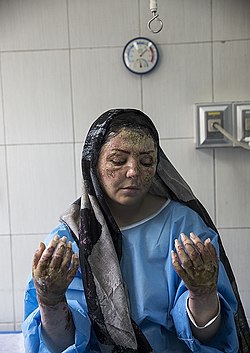
Back اعتداءات رش الحمض Arabic এচিদ আক্ৰমণ Assamese Абліванне кіслатой Byelorussian Заливане с киселина Bulgarian অ্যাসিড নিক্ষেপ Bengali/Bangla Atac amb àcid Catalan Útok kyselinou Czech Säureattentat German Acida atenco Esperanto Ataque con ácido Spanish

An acid attack,[1] also called acid throwing, vitriol attack, or vitriolage, is a form of violent assault[2][3][4] involving the act of throwing acid or a similarly corrosive substance onto the body of another "with the intention to disfigure, maim, torture, or kill".[5] Perpetrators of these attacks throw corrosive liquids at their victims, usually at their faces, burning them, and damaging skin tissue, often exposing and sometimes dissolving the bones. Acid attacks can lead to permanent partial or complete blindness.[6]
The most common types of acid used in these attacks are sulfuric and nitric acid. Hydrochloric acid is sometimes used but is much less damaging.[7] Aqueous solutions of strongly alkaline materials, such as caustic soda (sodium hydroxide) or ammonia, are used as well, particularly in areas where strong acids are controlled substances.[8][9][10]
The long-term consequences of these attacks may include blindness, as well as eye burns, with severe permanent scarring of the face and body,[11][12][13] along with far-reaching social, psychological, and economic difficulties.[5]
Although acid attacks occur all over the world, this type of violence is most common in developing regions,[14] particularly South Asia.[15] It is often a form of gender-based violence, with "a disproportionate impact on women" according to Acid Survivors Trust International (ASTI).[16] However, in countries such as the United Kingdom where acid attacks are associated primarily with gang violence, the majority of both perpetrators and victims are male.[17]
- ^ "Cambodian victim on her acid attack". BBC News. 21 March 2010. Archived from the original on 25 March 2010. Retrieved 23 April 2010.
- ^ Karmakar, R.N. (2010). Forensic medicine and toxicology (3rd ed.). Kolkata, India: Academic Publishers. ISBN 9788190908146.
- ^ "World Now (blog)". Los Angeles Times. November 2011. Retrieved 20 April 2016.
- ^ "Man who threw acid at woman blames 2 others". Los Angeles Times. 19 March 1992. Retrieved 20 April 2016.
- ^ a b CASC (May 2010). Breaking the silence: addressing acid attacks in Cambodia (PDF). Cambodian Acid Survivors Charity (CASC). Archived from the original (PDF) on 19 December 2013. Retrieved 3 April 2016.
- ^ Swanson, Jordan (Spring 2002). "Acid attacks: Bangladesh's efforts to stop the violence". Harvard Health Policy Review. 3 (1). Harvard Internfaculty Initiative in Health Policy: 3. Archived from the original on 17 January 2006. Retrieved 1 October 2018.
- ^ Welsh, Jane (Fall 2006). ""It was like burning in hell": A comprehensive exploration of acid attack violence" (PDF). Carolina Papers on International Health. 32. Center for Global Initiatives, University of North Carolina. Archived from the original (PDF) on 23 January 2013. Retrieved 3 April 2016.
- ^ Kelleher, Olivia (2 March 2023). "Man who threw acid in woman's face and set fire to her home jailed for 11 and a half years". TheJournal.ie.
- ^ "Woman jailed for caustic soda attack". BBC News. 24 September 2014. Retrieved 11 October 2017.
- ^ Brown, Malcolm (17 July 2009). "Acid attack accused is refused bail". The Sydney Morning Herald. Retrieved 11 October 2017.
- ^ Bandyopadhyay, Mridula; Rahman Khan, Mahmuda (2003). "Loss of face: violence against women in South Asia". In Manderson, Lenore; Bennett, Linda Rae (eds.). Violence against women in Asian societies. London New York: Routledge. pp. 61–75. ISBN 9781136875625.
- ^ AP (12 November 2000). "Bangladesh combats an acid onslaught against women". CNN. Archived from the original on 22 September 2007. Retrieved 13 March 2008.
- ^ Bahl, Taur; Syed, M. H. (2003). Encyclopaedia of Muslim world. New Delhi: Anmol Publications. ISBN 9788126114191.
- ^ "A worldwide problem". Acid Survivors Trust International. Retrieved 3 November 2024.
- ^ "Q&A: Acid attacks around the world". Edition.cnn.com. Retrieved 20 April 2016.
- ^ "A worldwide problem". Acid Survivors Trust International. Retrieved 3 November 2024.
- ^ "Everything you know about acid attacks is wrong". BBC Three. 17 November 2017. Retrieved 1 February 2019.